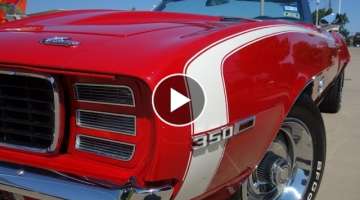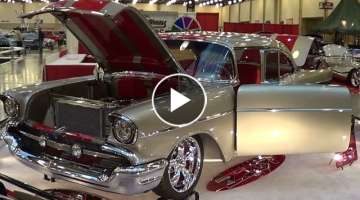Classic Car Conversation | @lonestarlows | 1968 Chevrolet Impala Fastback
The Impala has become one of the Chevrolet's most popular and enduring nameplates, offering upscale trim, amenities, and style from its introduction in 1958. When it was new, Chevrolet Chief Engineer Ed Cole summed up the Impala and its market position best, stating it was a '…prestige car within reach of the average American citizen.' After several variations, the full-size Chevrolet models were redesigned for 1965, and buyers agreed with the all-new styling, evident by the over one million Impalas sold for 1965, a record that would never again be equaled.
The full-size Chevys were mildly updated for 1966 and then for 1967, they were given new 'Coke bottle' designs but continued to rest on the 119-inch wheelbase chassis. Several important safety features were introduced including side-marker lights, fully collapsible, energy-absorbing steering columns, and shoulder belts for closed body styles. Buyers had a wide array of choices for power, ranging from the base 250 cubic-inch 'Turbo Thrift' 6 and 283 cubic-inch 'Turbo Fire' V-8, and optional 275-horsepower, 327 cubic-inch 'Turbo Fire' V-8 and 325-horsepower, 396 cubic-inch 'Turbo Jet' V-8, plus the 385-horsepower and 425-horsepower 427 cubic-inch 'Turbo Jet' V-8s. Powerglide two-speed and three-speed Turbo-HydraMatic automatic transmissions were also now available, the latter available with the 327 and up.
The 1967 Chevy Impala gained upgraded door panels with carpeted lower sections. The list of available options grew in 1967 to include front disc brakes, fiber-optic light monitoring system, vacuum-operated power door locks, and a stereo 8-Track player. Closed body styles came standard with cloth-and-vinyl upholstery, with all-vinyl upholstery being a new extra-cost option in several color choices on all Impala sedan and coupe body styles. Vinyl upholstery was standard on the convertible and station wagon.
The late 1960s were the height of the muscle car wars with buyers facing a vast array of options that included the Dodge Daytona 500, the American Motors AMX, the Plymouth Superbird, and the Ford Mustang Mach I. Most of these were devoid of creature comforts and built specifically for all-out speed. Chevrolet enticed buyers with their Impala offered with a plethora of engine options, with the ultimate selection being the 427 cubic inch 'Big Block' V8, instantly transforming the average sleeper into a neck-snapping car capable of blistering performance. The Impala went beyond just performance, however, as it offered a highly-defined degree of comfort, with a large and spacious interior that could accommodate the entire family.
General Motors had banned 427 engines in 'mid-size' cars due to insurance reasons. Buyers wanting a 427 meant they had to order a COPO, a Corvette, or a full-size car for 1968. Approximately 568 examples of the 'full-size' cars were fitted with the L72 and 95-percent of those went into Bel Air or Biscayne (124 in the Biscayne) models It is believed that less than 30 Super Sport cars were built with this engine in 1968 and is often referenced as the 'SS 427' as the name 'Impala' is not mentioned anywhere on the car. Introduced in 1966 as an RPO option, the L72 engine option sported solid lifters and camshaft, 11:1 compression, 4-bolt main caps, massive, and high-flowing rectangular port heads. Their advertisements for 1966 claimed 450 horsepower, but this was problematic for the insurance companies, so hp claims were muted.
The RPO Z-03 Impala option was a Super Sport which had previously been a separate model with its own VIN designation, but for 1968, was part of the Impala family. The SS 427 (RPO Z-24) was another model option for the standard Impala. Unlike 1967, when the Z-24 option was basically combined with an Impala Super Sport to make the SS 427, in 1968 the SS 427 was a stand-alone option that could be had on the Sport Coupe, Convertible, and the new-for-1968 Custom Coupe. Due to declining sales which had begun in 1966, Chevrolet management removed the standard Impala Super Sport from a buyer's possible options, leaving only the SS 427 to carry on the full-sized Chevrolet Super Sport lineage for 1969. It is believed that Chevrolet built around 1,778 examples of the RPO Z-24 in 1968.
Chevrolet sold around 710,900 examples of their Impala in 1968, making it their most popular and top-selling full-size vehicle. The design was similar to the other full-size cars, except that a new formal-top roofline treatment was available. Bodystyles were extensive, including a sedan and hardtop sedan, Formal Top coupe, hardtop coupe, convertible, and 6- and 9-passenger station wagons. Pricing ranged from $2,850 - $3,360. Impala's came with a Deluxe steering wheel, door and window frame moldings, ignition switch, and luggage lights. They also had foam seat cushions in both the front and the rear. The convertibles had courtesy lights, all-vinyl upholstery and carpeting on lower door panels. Impala Sport Coupe models had thin metal rocker panel accent moldings below their doors along with metal wheel lip trim. The Super Sport and SS-427 equipment package were also available. The Impala Super Sport (RPO Z03) included a special all-vinyl interior, Strato-Bucket seats, and a center console. The RPO Z24 Impala SS-427 included Red Stripe tires, ornamentation, special suspension, 15-inch wheels, and a 385HP V8. They had side 'gill' fender vents, power disc brakes, SS badging on the trunk, dash steering wheel, and grille, and a special raised hood.
Around 24,730 Impala's were given the convertible body style. The majority of Impala's came equipped with V8 engines. Just 7,700 were given an overhead-valve six-cylinder engine rated at 155 horsepower. A 307 cubic-inch V8 offered 200 horsepower and the RPO L36 Turbo-Jet V8 brought the horsepower figure up to 385. An RPO L72 Turbo-Jet V8, adding an additional $542 to the cost of the vehicle, brought the figure up to 425 horsepower.
VIDEO
Facebook Comments































